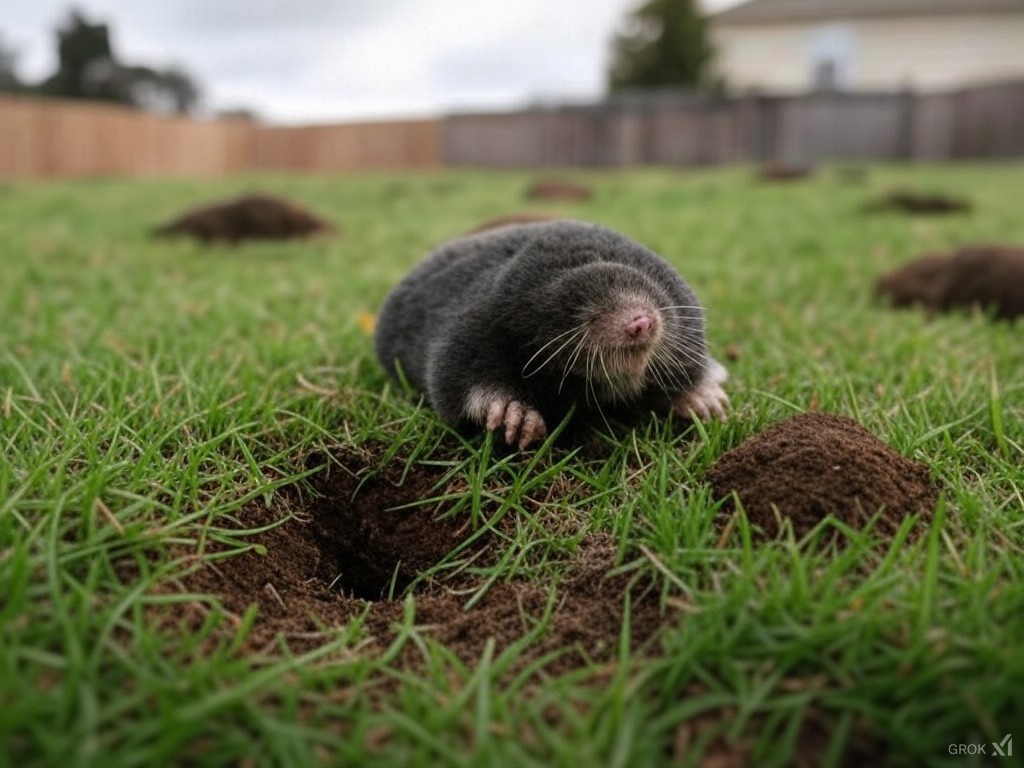Eastern moles (Scalopus aquaticus) can cause significant damage to lawns and landscaping, primarily through their burrowing activities. Mole trapping is done with lethal traps and continues until no new damage occurs.

Here’s an overview of the kind of damage they can inflict:
Lawn Damage:
- Molehills and Tunnels:
- Surface Tunnels: Moles create raised tunnels just below the surface of the lawn, which look like long, winding ridges. These can disrupt the appearance of the lawn and make mowing difficult.
- Molehills: They push up soil from their deeper burrows, creating molehills or mounds of dirt. These can be numerous, marring the lawn’s aesthetics and making it uneven, which can lead to trip hazards.
- Root Damage:
- While primarily eating insects and grubs, moles can inadvertently damage plant roots by disrupting the soil around them. This can affect grass health, leading to dead patches.
- Aeration Holes:
- Their tunnels can aerate the soil to some extent, but this is usually offset by the aesthetic and functional damage.
Landscaping Damage:
- Garden Beds:
- Moles might tunnel through garden beds, disturbing the layout and potentially damaging the root systems of flowers, shrubs, or vegetables. This can lead to plant death or stunted growth.
- Compacted Soil:
- Their burrowing can compact the soil in some areas, making it harder for water to penetrate, which can indirectly affect plant health.
- Erosion:
- In sloped areas, mole tunnels can lead to erosion, especially after heavy rain when water can follow the paths of the tunnels, washing away soil.
Additional Considerations:
- Irrigation Systems: In some cases, moles might accidentally damage underground irrigation lines while digging, though this is less common than other forms of damage.
- Attracting Other Pests: The disturbed soil can attract other pests like voles, which might use mole tunnels for their own purposes, leading to further damage.
Indirect Effects:
- Plant Health: While moles don’t eat plants directly, the damage to root systems or soil structure can make plants more susceptible to diseases or less able to absorb nutrients and water.
- Cost of Repair: Repairing mole damage can be time-consuming and costly, from re-grading the lawn, resodding, or replanting to fixing irrigation systems.
Mitigation:
- Trapping: Humane trapping can be effective if you can locate the active tunnels.
- Repellents: Chemical or ultrasonic repellents with varying degrees of success.
- Barriers: Deep mesh barriers around valuable areas, though this is more practical for small, specific areas rather than large lawns.
- Habitat Modification: Reducing the grub population can make the area less attractive to moles.
While moles do contribute to soil aeration, the amount of damage they cause often outweighs this benefit in a maintained lawn or garden setting. It’s important to approach mole control with effective methods, considering local wildlife regulations, and sometimes professional pest control might be necessary for severe infestations.
